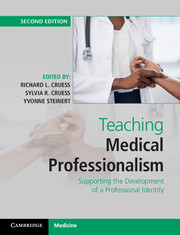Book contents
- Frontmatter
- Contents
- List of contributors
- Foreword
- Introduction
- Part I What is to be taught and learned
- Part II Theory
- 3 Theoretical insights into the nature and nurture of professional identities
- 4 Socialization, professionalism, and professional identity formation
- 5 Educational theory and strategies to support professionalism and professional identity formation
- 6 Role modeling and mentoring in the formation of professional identity
- 7 Experiential learning and reflection to support professionalism and professional identity formation
- Part III Principles
- Part IV Case studies in promoting professionalism and professional identity formation across the continuum
- Part V The future
- Index
- References
4 - Socialization, professionalism, and professional identity formation
from Part II - Theory
Published online by Cambridge University Press: 05 April 2016
- Frontmatter
- Contents
- List of contributors
- Foreword
- Introduction
- Part I What is to be taught and learned
- Part II Theory
- 3 Theoretical insights into the nature and nurture of professional identities
- 4 Socialization, professionalism, and professional identity formation
- 5 Educational theory and strategies to support professionalism and professional identity formation
- 6 Role modeling and mentoring in the formation of professional identity
- 7 Experiential learning and reflection to support professionalism and professional identity formation
- Part III Principles
- Part IV Case studies in promoting professionalism and professional identity formation across the continuum
- Part V The future
- Index
- References
Summary
History is opaque. You see what comes out, not the script that produces events, the generator of history.
Introduction
In this chapter, we will examine issues of professionalism and professional identity formation through the particular lens of socialization theory. The fundamental assumption driving this chapter is my belief that current discussions about professionalism, and to a lesser extent professional identity formation, contain a bevy of unexamined assumptions about what happens to learners as they move from the social and social–psychological status of lay outsiders to full members in a particular occupational group – in this case, medicine. The largely tacit nature of these suppositions, in turn, may block or otherwise distort meaningful efforts by medical educators to optimally link medical education with the principles and practices of professionalism and identity formation. Until these disconnects and contradictions are made more explicit, efforts to develop and deploy effective educational interventions will be less than optimal.
To facilitate this examination, I treat medicine's current professionalism movement as discourse and analyze “how the specialized language of academic medicine disciplines has defined, organized, contained, and made seemingly immutable a group of attitudes, values, and behaviors subsumed under the label of ‘professionalism.’”2 My principal focus will be on the discourse of professionalism that has emerged since the mid 1980s, a period I consider to be the general launching point for organized medicine's modern-day professionalism movement. This discourse is marked by calls for physicians to recommit themselves to an ethic of professionalism – an ethic grounded in selfless service (e.g., altruism) and an ethic calling for the transformation of practitioners at the level of core values and self-identity. This discourse identifies medical schools as the primary change agent with medical students being the principal foci. While this discourse has evolved to include calls for changing educational institutions at the level of organizational culture, there are few details about how to link the structure, process, and content of education with the called-for changes in outcomes. Perhaps most consequentially, this discourse is awash with often inconsistent and conflicting references to professionalism across a broad variety of social–cognitive entities such as behaviors, attitudes, values, motives, and tendencies.
- Type
- Chapter
- Information
- Teaching Medical ProfessionalismSupporting the Development of a Professional Identity, pp. 54 - 67Publisher: Cambridge University PressPrint publication year: 2016
References
- 14
- Cited by



